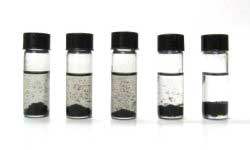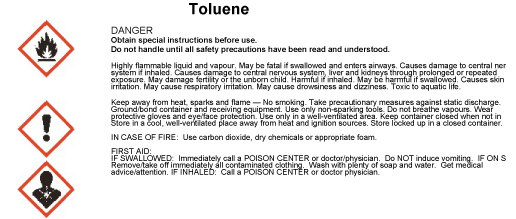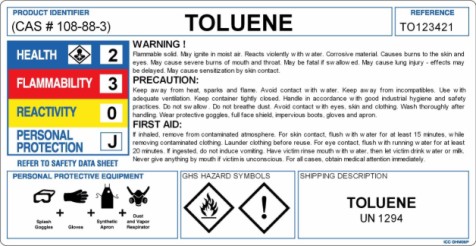|

Toluene, also known as methylbenzene,
or Toluol, is a clear
water-insoluble liquid with the typical smell
of
paint thinners, reminiscent of the related compound
benzene.
It is an
aromatic hydrocarbon that is widely used
as an industrial
feedstock and as a
solvent.
Like other solvents, toluene is also used as an
inhalant drug for its intoxicating properties; however this causes
severe neurological harm.
Chemicals
 Toluene
Toluene




Synonyms:
Methylbenzene; Toluol; Phenylmethane
CAS No.: 108-88-3
Molecular Weight: 92.14
Chemical Formula: C6H5-CH3
Health Rating: 2 - Moderate (Life)
Flammability Rating: 3 - Severe (Flammable)
Reactivity Rating: 1 - Slight
Contact Rating: 3 - Severe (Life)
Lab Protective Equip: GOGGLES & SHIELD; LAB COAT & APRON; VENT HOOD;
PROPER GLOVES; CLASS B EXTINGUISHER
Storage Color Code: Red (Flammable)

Properties
Synonyms: Methylbenzene; Toluol; Phenylmethane
CAS No.: 108-88-3
Molecular Weight: 92.14
Chemical Formula: C6H5-CH3
Molecular formula C7H8 (C6H5CH3)
Toluene CAS number 108-88-3

Appearance
Clear colorless, liquid
Density 0.8669 g/mL, liquid
Melting point −93 °C
Boiling point 110.6 °C
Solubility in water 0.47 g/l (20-25°C)
Viscosity 0.590 cP at 20°C
Structure Dipole moment 0.36 D
Hazards MSDS External MSDS
Toluene reacts as a normal aromatic hydrocarbon towards electrophilic
aromatic substitution.The methyl group makes i
t around 25 times more reactive than benzene in such reactions.
It undergoes smooth sulfonation to give p-toluenesulfonic acid, and
chlorination by Cl2 in the presence of FeCl3 to give
ortho and para isomers of chlorotoluene.
It undergoes nitration to give ortho and para nitrotoluene isomers, but
if heated it can give dinitrotoluene and ultimately
the explosive trinitrotoluene
With other reagents the methyl side chain in toluene may react,
undergoing oxidation. Reaction with potassium
permanganate leads to benzoic acid, whereas reaction with chromyl
chloride leads to benzaldehyde (Étard reaction).
Halogenation can be performed under free radical conditions. For
example, N-bromosuccinimide (NBS) heated with
toluene in the presence of AIBN leads to benzyl bromide.
Catalytic hydrogenation of toluene to methylcyclohexane requires a high
pressure of hydrogen to go to completion,
because of the stability of the aromatic system. pKa is approximately
45.
Usage:
Toluene is an Aromatic chemical produced by Petroleum Refineries/
Petrochemical Plants. Steel plants produce Toluene
from the by-product recovery plant where aromatics are recovered from
the coke oven gas.
Toluene is used mainly in production of various downstream
petrochemicals, pesticides, explosives (Tri-Nitro Toluene),
Adhesives, Saccharins, etc. Besides Toluene finds a major end-use in
paint industry as thinner. Toluene is also used
as solvents in various chemical industries.
Toluene is a parent substance in the manufacture of benzene derivatives,
caprolactam, saccharine, pharmaceuticals,
dyes, perfumes, TNT and detergents. It is used in fuels (anti-knock
additive) and as a solvent for paints and coatings,
rubber, resins, thinners in nitrocellulose lacquers and adhesives.
It serves as a raw material in the manufacture of phenol (predominantly
in Western Europe), benzene, cresol (chiefly Japan) and a wide range of
other substances.
Toluene chemical is also known as phenyl-methane or methyl-benzene.
This chemical is transparent like pure water but not soluble in water.
This has a smell like paint thinners and redolent of the sweet fragrance
alike benzene compound.
Toluene chemicals belong to aromatic hydrocarbon group and are widely
used as solvents and industrial feedstock. Further, these can be used as
inhalant drugs for their intoxicating properties.
Hazards Identification
Health Rating: 2 - Moderate (Life)
Flammability Rating: 3 - Severe (Flammable)
Reactivity Rating: 1 - Slight
Contact Rating: 3 - Severe (Life)
Lab Protective Equip: GOGGLES & SHIELD; LAB COAT & APRON; VENT HOOD;
PROPER GLOVES; CLASS B EXTINGUISHER
Storage Color Code: Red (Flammable)
Handling and Storage
Protect against physical damage. Store in a cool, dry well-ventilated
location, away from any area where the fire hazard may be acute. Outside
or detached storage is preferred. Separate from incompatibles.
Containers should be bonded and grounded for transfers to avoid static
sparks. Storage and use areas should be No Smoking areas. Use
non-sparking type tools and equipment, including explosion proof
ventilation.
Containers of this material may be hazardous when empty since they
retain product residues (vapors, liquid); observe all warnings and
precautions listed for the product.

Ingredient CAS No Percent Hazardous
--------------------- ------------ ------------ ---------
Toluene 108-88-3 100% Yes
| |
|
Note /Government
Notification: These chemicals are designated as those that are used
in the manufacture of the controlled substances and are important to
the manufacture of the substances. For any (Control Substance)
products Import and Export *** subjected to your country government
laws /control substance ACT.
Information: The information on this web page is provided to help
you to work safely, but it is intended to be an overview of hazards,
not a replacement for a full Material Safety Data Sheet (MSDS). MSDS
forms can be downloaded from the web sites of many chemical
suppliers. ,also that the information on the PTCL Safety web site,
where this page was hosted, has been copied onto many other sites,
often without permission. If you have any doubts about the veracity
of the information that you are viewing, or have any queries, please
check the URL that your web browser displays for this page. If the
URL begins "www.tajapi.com/www/Denatonium Benzoate.htm/" the page is
maintained by the Safety Officer in Physical Chemistry at Oxford
University. If not, this page is a copy made by some other person
and we have no responsibility for it.
The Controlled Substances Act (CSA) was enacted into law by the
Congress of the United States as Title II of the Comprehensive Drug
Abuse Prevention and Control Act of 1970.[1] The CSA is the federal
U.S. drug policy under which the manufacture, importation,
possession, use and distribution of certain substances is regulated.
The Act also served as the national implementing legislation for the
Single Convention on Narcotic Drugs |
 New Chemicals
New Chemicals
Diethyl ether,
Potassium permanganate,
Toluene,
Diethyl ether,
Potassium permanganate,
Methyl isobutyl ketone,
Para Anisyl Choride,
Methyl Tyramine,
Para
Cresyl Acetate,
Anisyl Formate,
Ortho Anisic Aldehyde,
3-Benzyloxy Propionitrile,
Veratrol,
Manganese Sulphate Monohydrate

Details


Emergency
Overview
--------------------------
POISON! DANGER! HARMFUL OR FATAL IF SWALLOWED. HARMFUL IF INHALED OR
ABSORBED THROUGH SKIN. VAPOR HARMFUL. FLAMMABLE LIQUID AND VAPOR. MAY
AFFECT LIVER, KIDNEYS, BLOOD SYSTEM, OR CENTRAL NERVOUS SYSTEM. CAUSES
IRRITATION TO SKIN, EYES AND RESPIRATORY TRACT.
|
|










 New Chemicals
New Chemicals